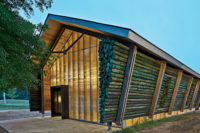Massachusetts
Combining a horse barn and welding studio in one small building is hardly a run-of-the-mill commission. But projects with unlikely programmatic marriages are not new to the parties involved in creating this wood-framed workshop-cum-stable in Massachusetts.
Ten years ago, Boston-based Kennedy & Violich Architecture designed a house addition for a couple with grown children on their wooded property northwest of the city [Record Houses, April 2000, page 94]. Reflecting both the husband’s and wife’s separate and shared interests, the architects pulled off the feat of fluidly inserting a 48-foot-long swimming pool in the middle of the living room and private art gallery. Once settled into their new home, the clients again approached the architects, this time with a request to replace a structure on their property that housed both the wife’s horses and the husband’s metal shop. The outbuilding was ailing and, over time, had become too cramped for both uses, which raised questions about comfort and safety.
The husband, who sculpts as a hobby, requested a new, larger studio and workshop where he could conceive and build his artworks. He needed a protected outdoor work area with a gantry where he could off-load materials regardless of weather conditions. After years of keeping horses in makeshift accommodations, the wife desired an equestrian typology, something that “really felt like a barn,” she says. Additionally, the clients asked for flexibility: that the building be easily converted into a house should needs change in the future.
“We treated this project as a shed,” says firm principal Frano Violich, FAIA. “We kept the materials as raw and simple as possible. It is a working space. We did not want to take it to a revered level.” In this vein, the architects designed the building as one long, gabled volume, cranked at its center. In juxtaposition to the neighboring house, which has an origamilike roof plane that folds up in places to admit indirect light, the barn’s simple gable has more to do with capturing additional space. A clerestory runs along the roof’s east side and continues on the canopy over the loading court, adding dimension to the gable and admitting light into both the interior and exterior work areas.
The building skin consists of a conventional pine board-and-batten cladding system, but the architects played with the treatment a bit. They removed the battens on the unheated horse barn, allowing for daylighting and ventilation and causing it to glow at night. “It’s beautiful,” says one of the clients. “I can see it from my home, and it twinkles.” The architects also applied a natural pigment on the north side of the batten, resulting in a subtle red flash when viewed from an angle. Concealed doors incorporated into the facades render the elevations clean planes, despite the number of large apertures dictated by the programs.
Though the clients wanted to save the old structure’s concrete basement walls, they were damaged during excavation, so the team poured a completely new basement. From the outside, the building appears to be a simple, one-level barn. Inside, it is a dynamic three-story space, with a wood shop and loading area on the main floor; a small, loftlike studio above; and a large metal shop below. Despite the fact that the building is timber-framed (with the exception of two steel columns to support the gantry), no special fireproofing was required—all welding is done in the concrete well below grade.
The rippling metal ribbon that clads the eastern interior wall and continues up to the roof beams is the result of the husband’s desire to collaborate with the construction team, and represents the intersection of building and sculpture. The fanciful topography he designed serves as a calling card for this temple to metalwork. Made of standard metal flashing, the piece also captures the architects’ spirit. “We like to use materials for purposes other than their original intents,” says Violich. The installation’s function transcends visual interest: It reflects light, and the voids between the slats provide sound absorption.
The barn and workshop meet at the crank, where there is a tack room, as well as a bathroom squeezed into an acutely angled pocket space. This interstitial area also leads to a stair down to the building’s back, and to the hay loft, which is reached by crossing a narrow bridge above the two horse stalls below. The wife counseled Kennedy & Violich on horse-barn requirements: stall dimension, access points for hay delivery and manure removal, accommodations for cross-tying horses for grooming and veterinary treatment, the relationship of the building to the paddock, and connections to the field beyond.
With this little barn in the woods, Kennedy & Violich has found a common language for meeting the needs of and physically expressing the two clients’ divergent interests. In so doing, the team, rather than emphasizing the tension between the programs, has revealed less evident connections and has demonstrated how a requirement for one can feed a solution for the other. And isn’t it these very same principles that lie at the core of any good relationship?


